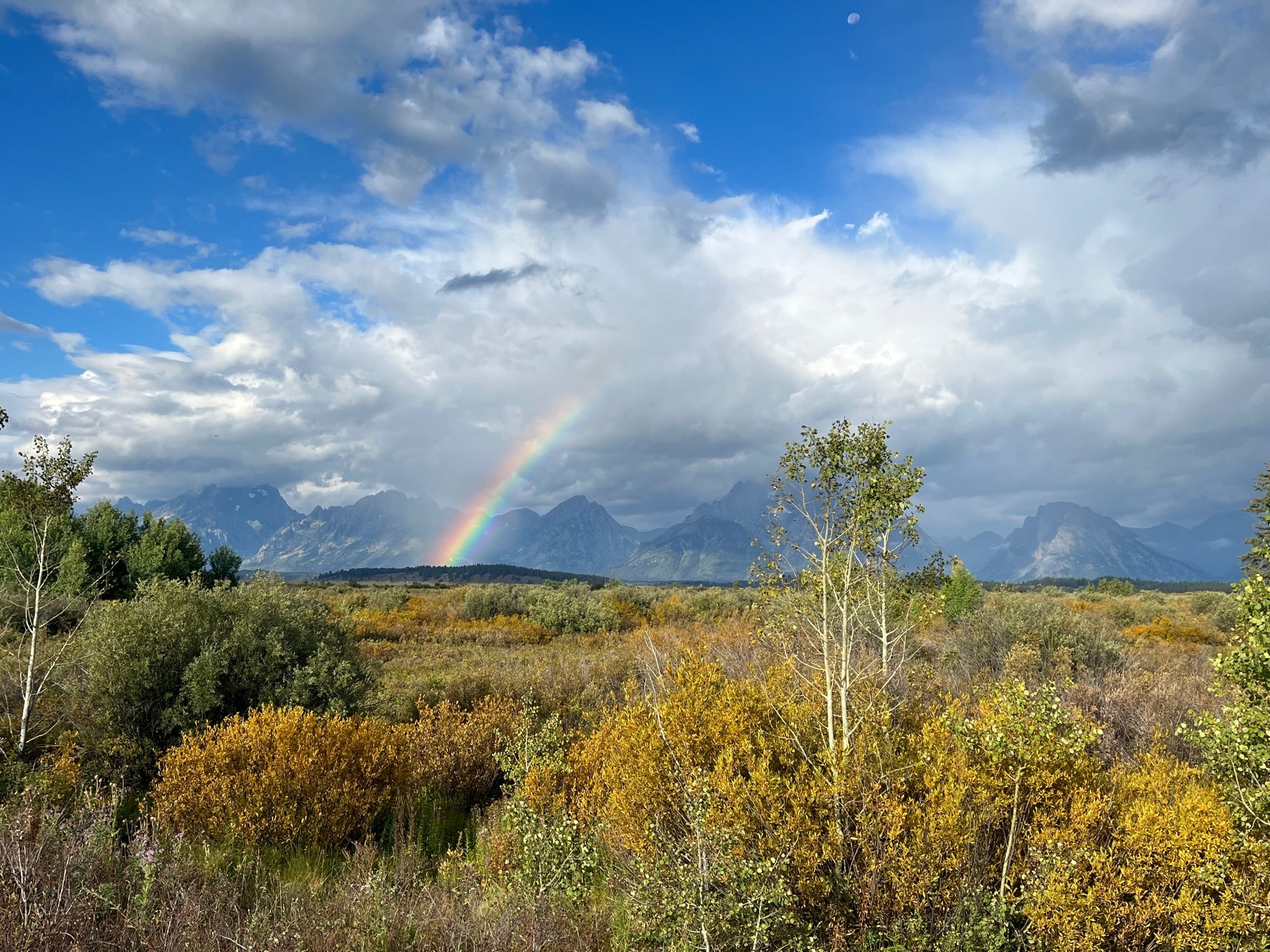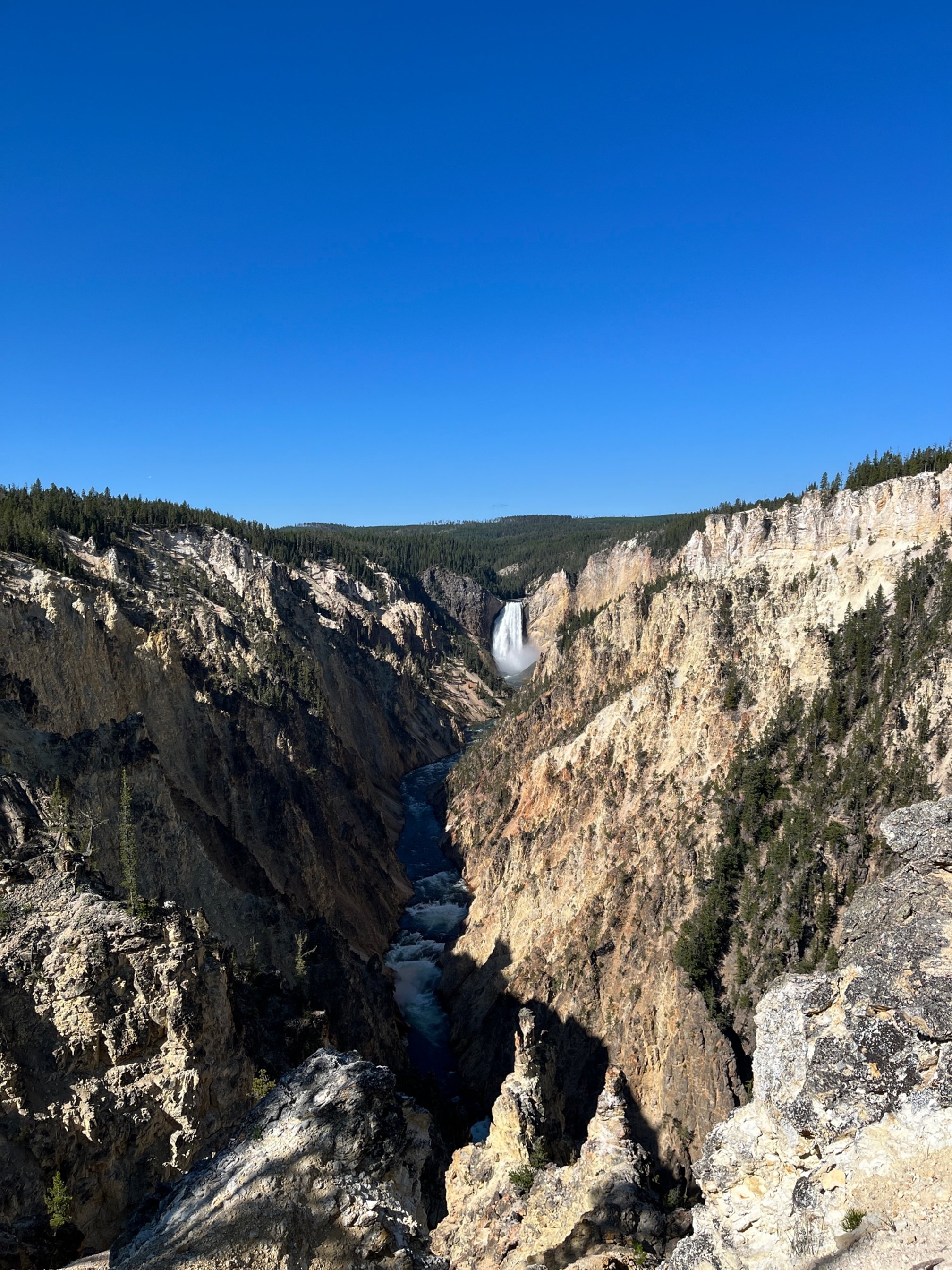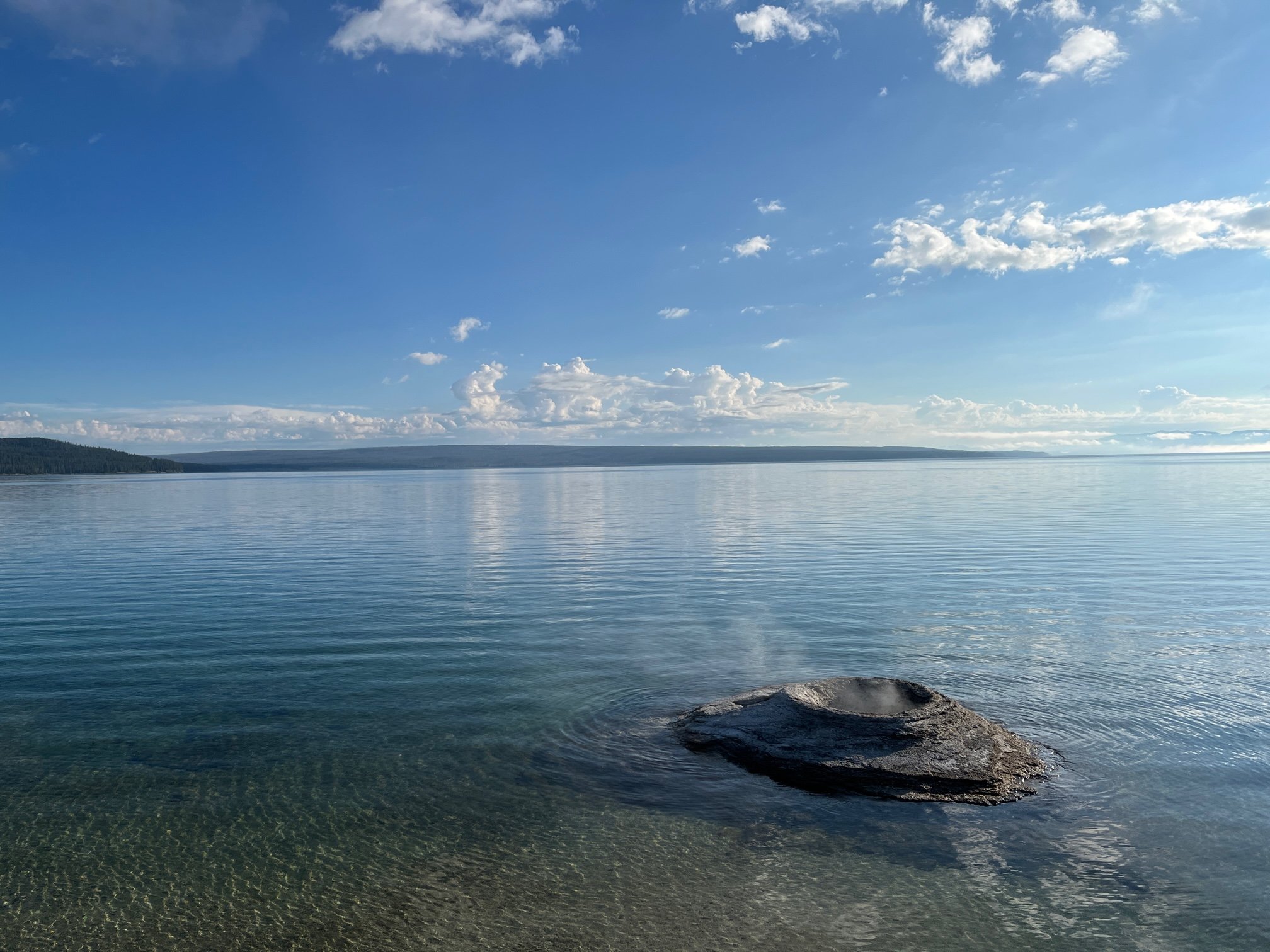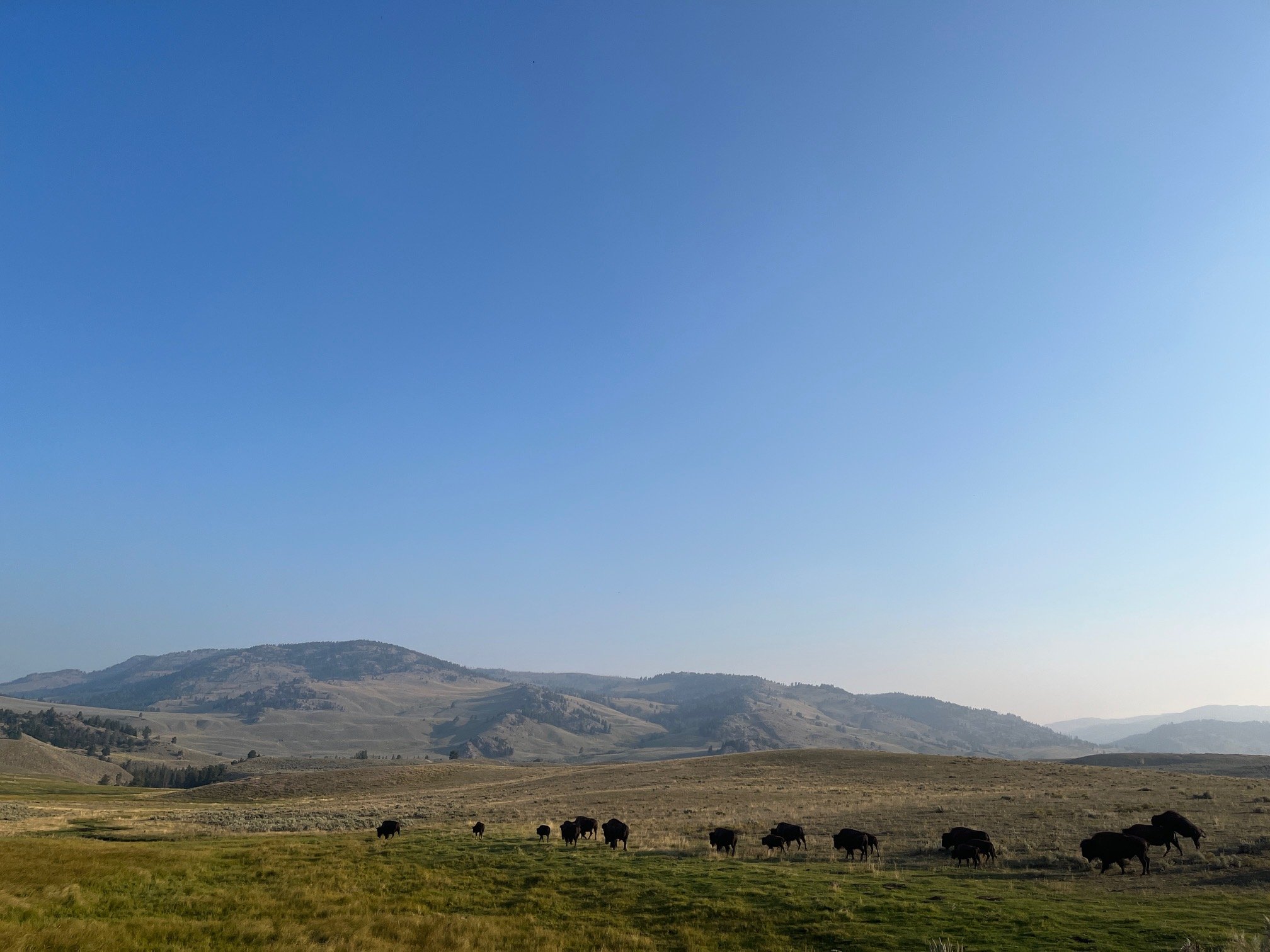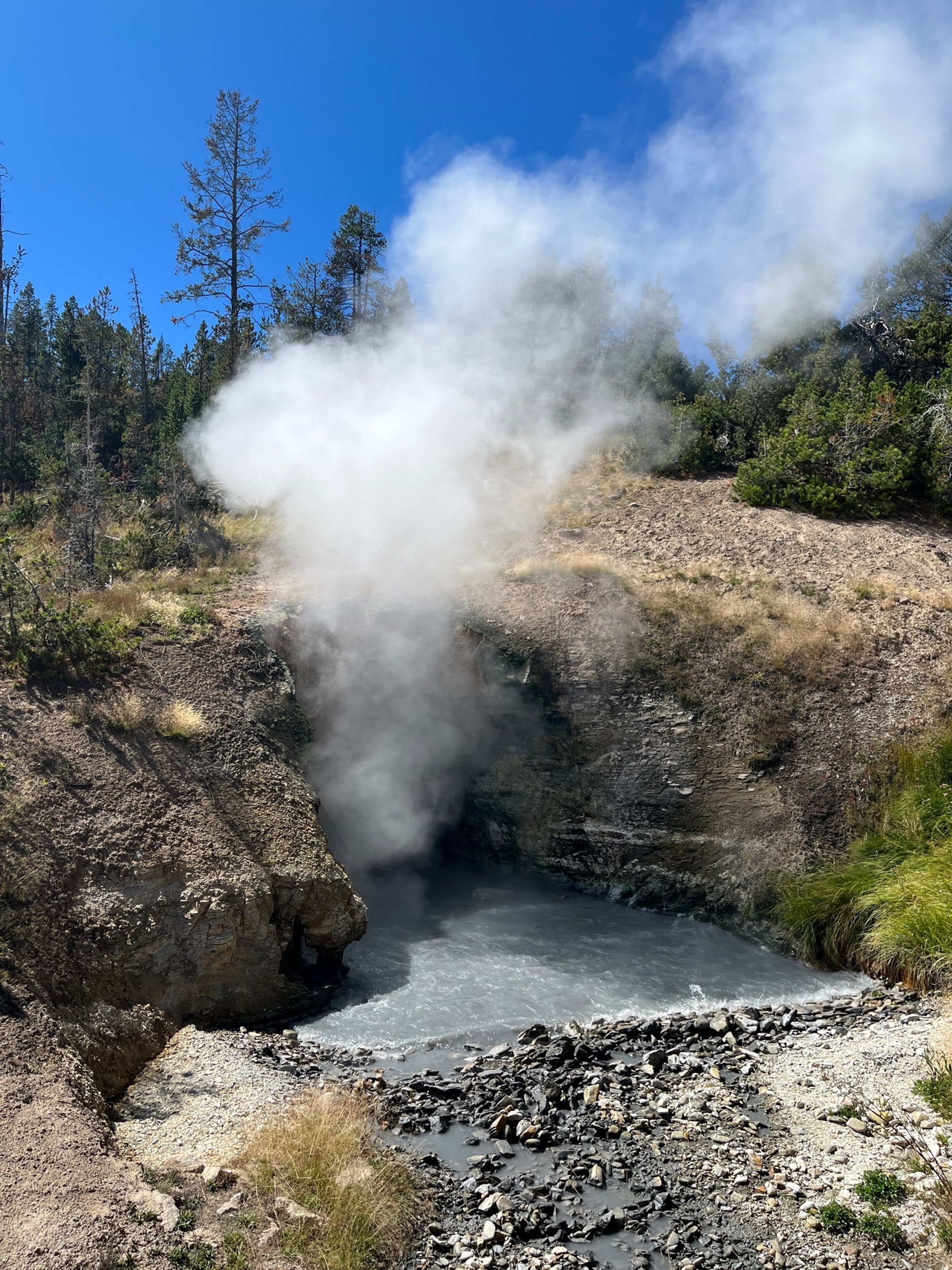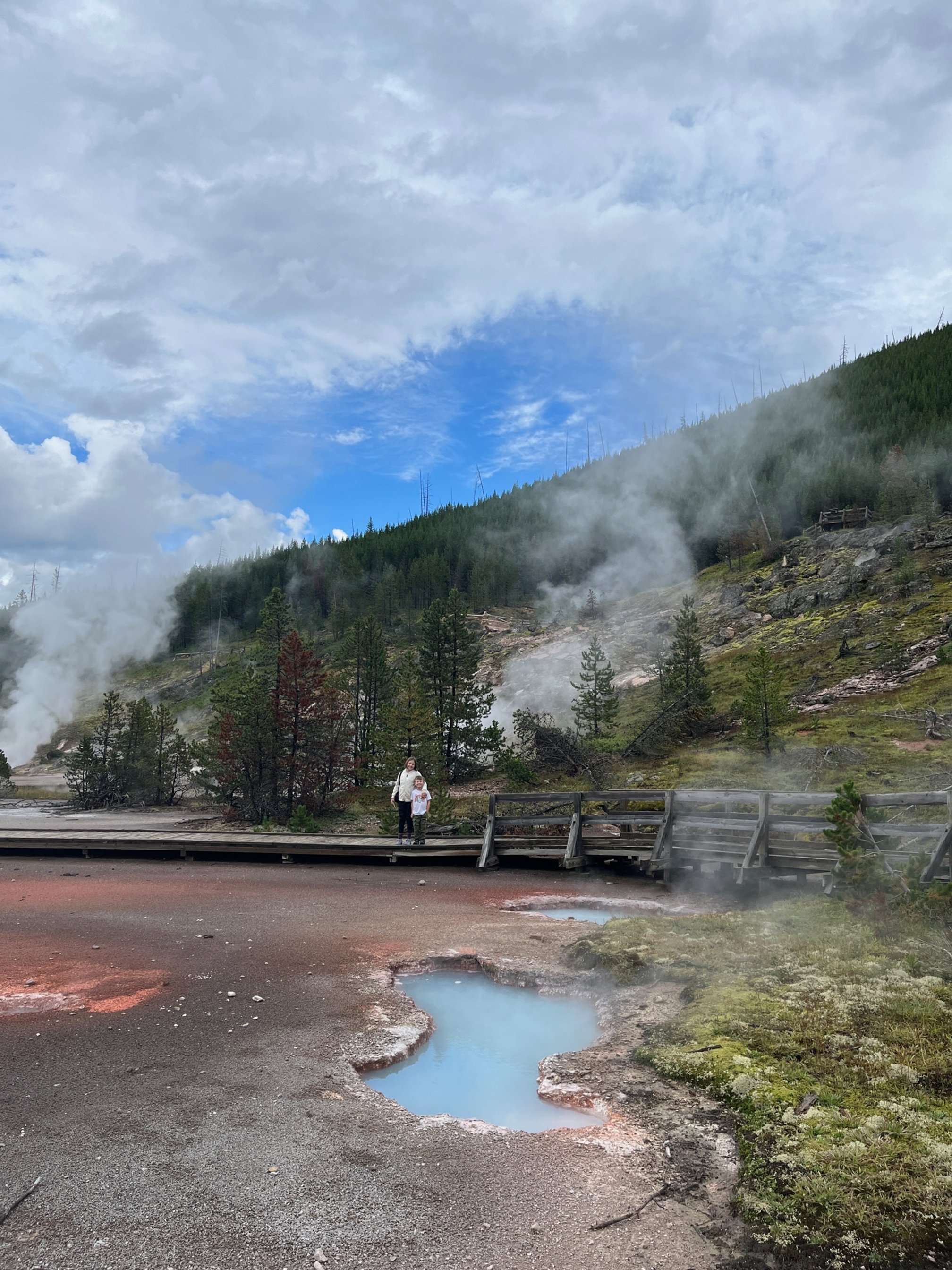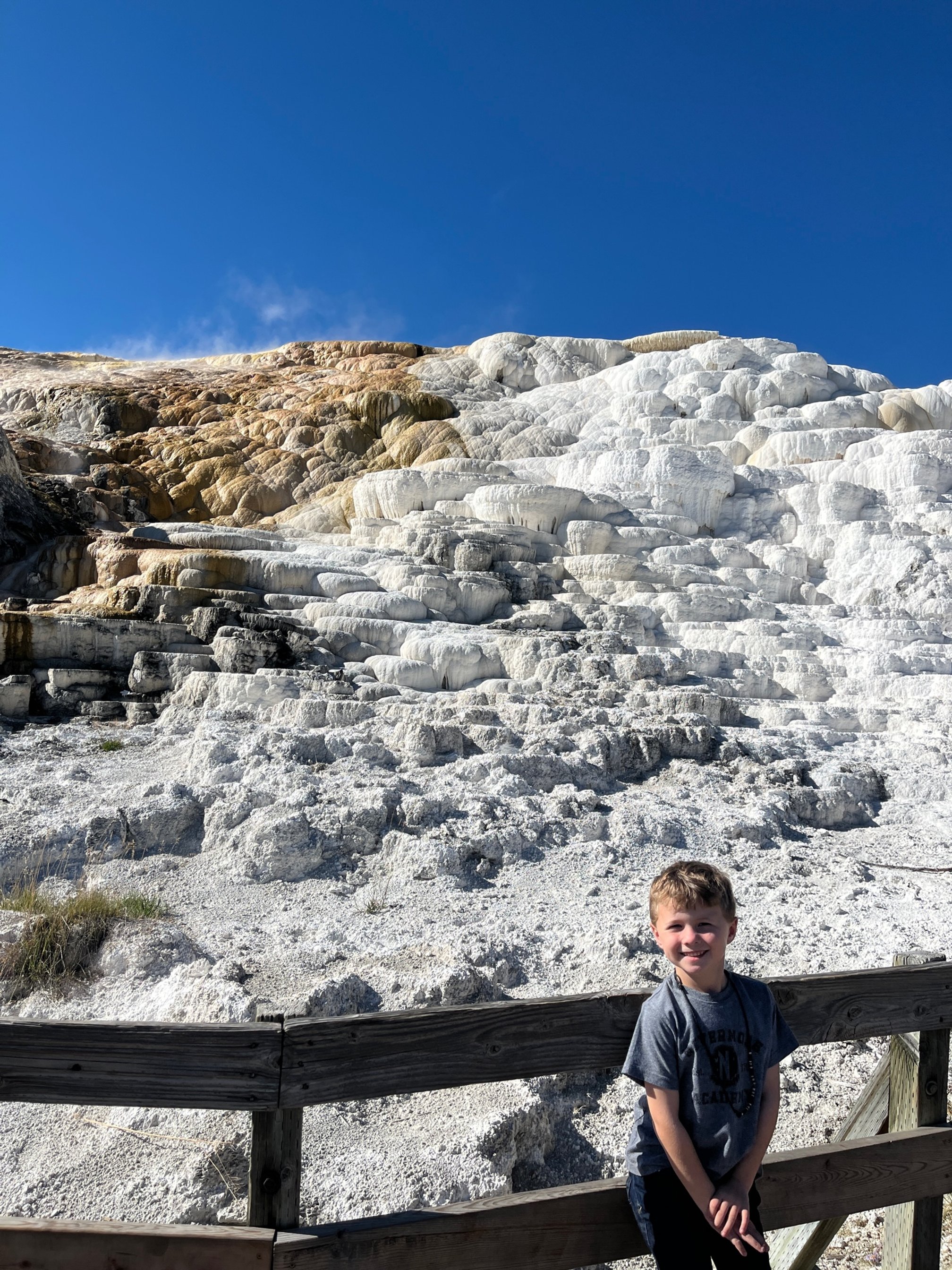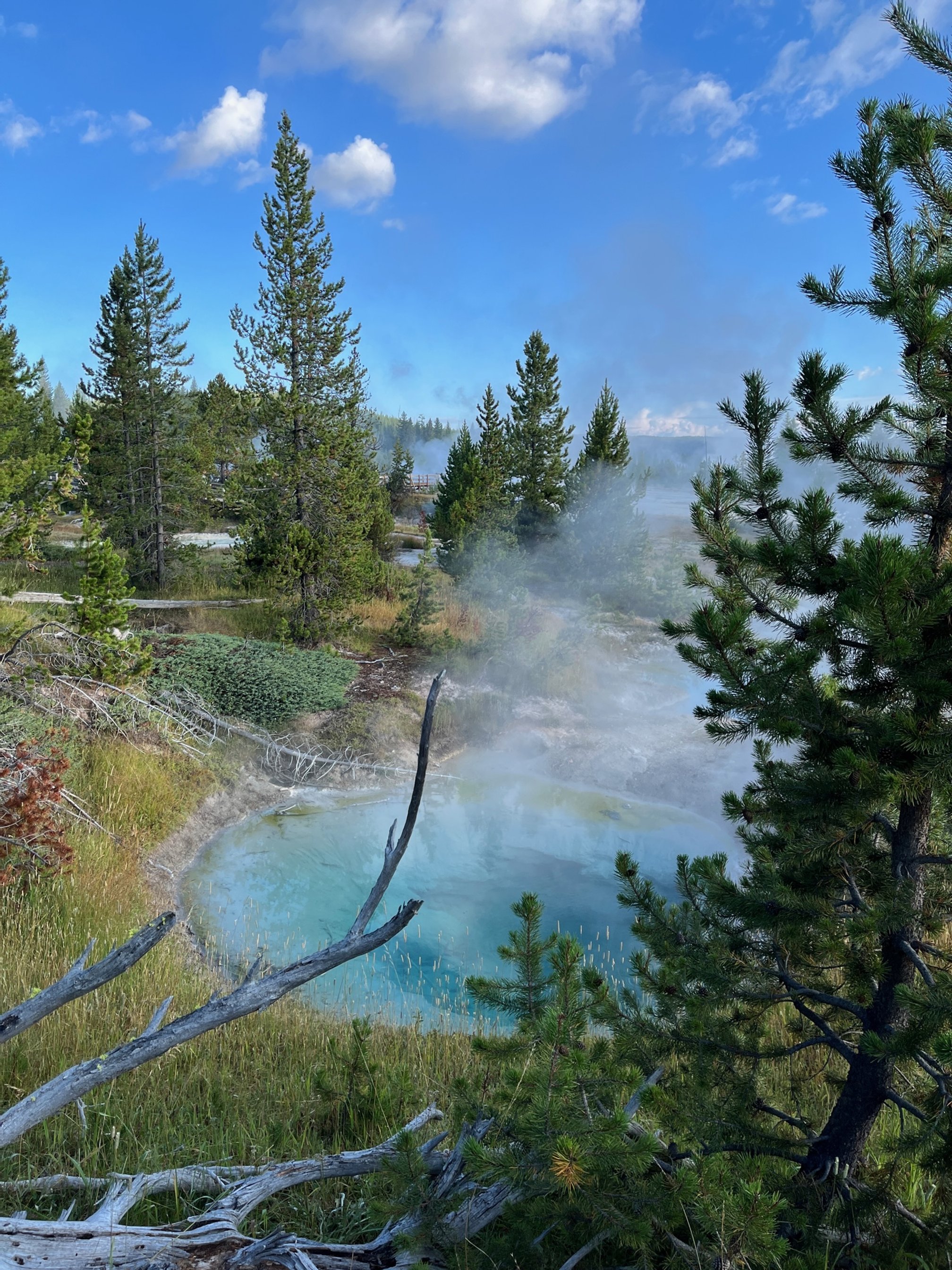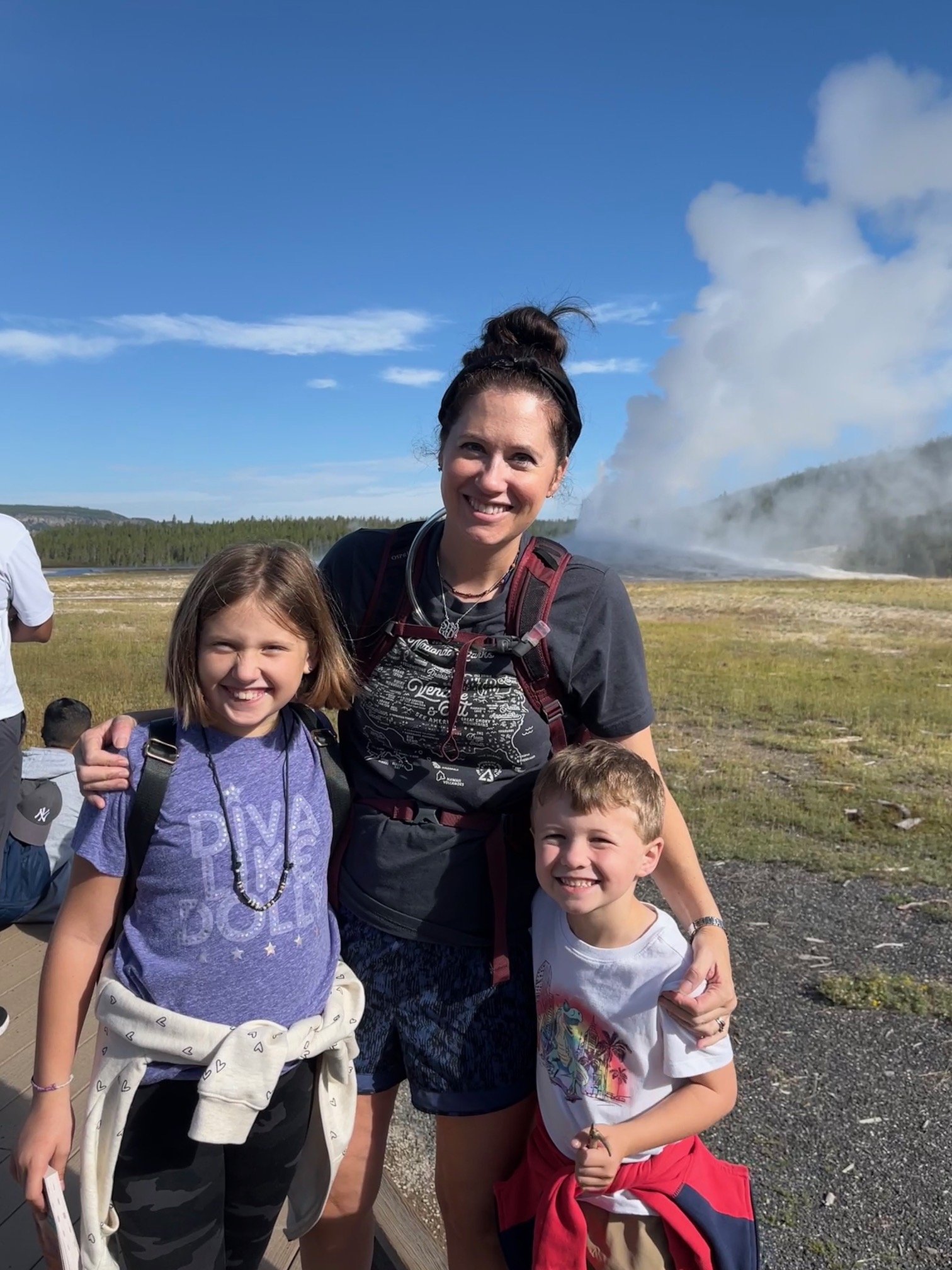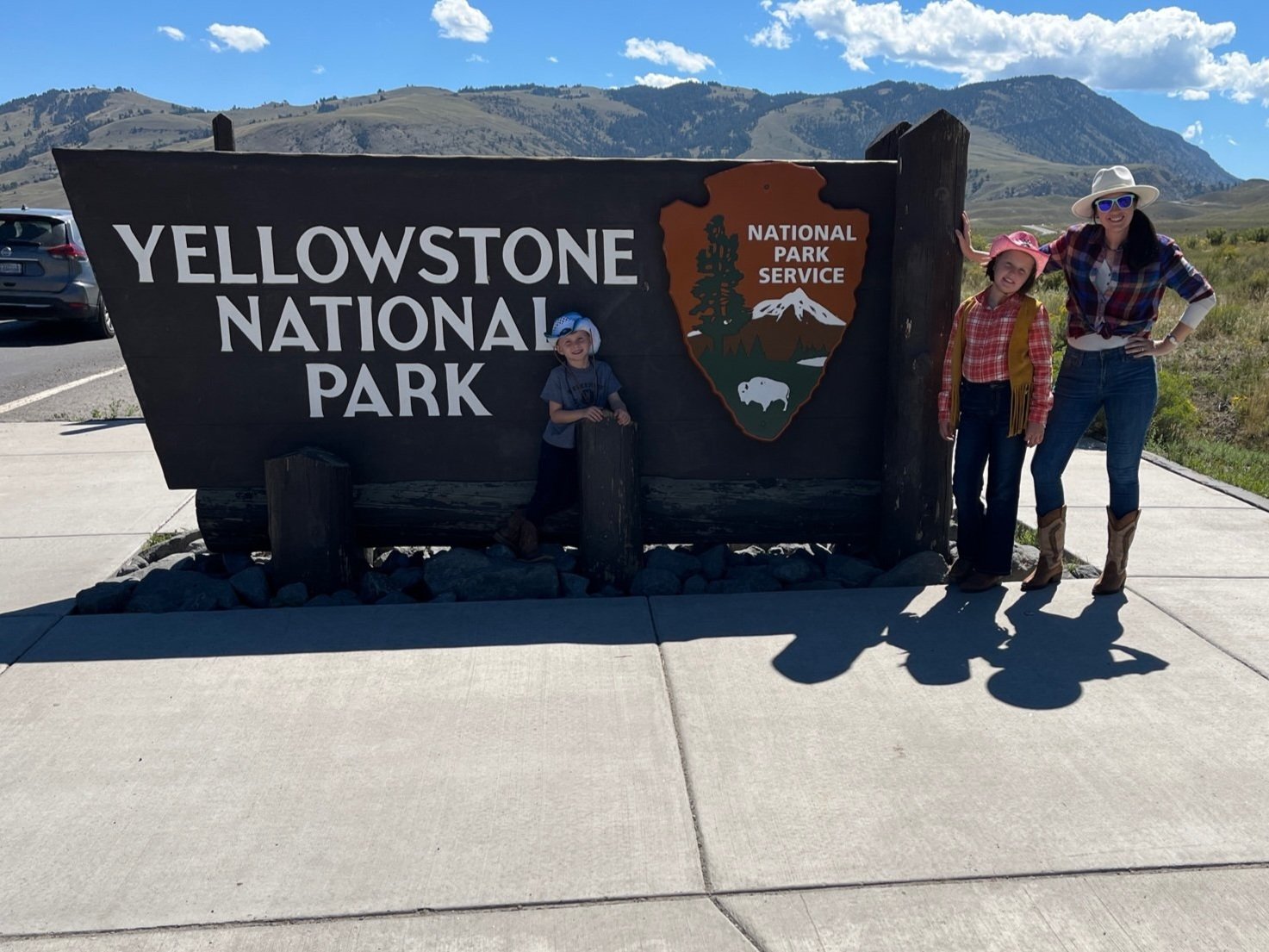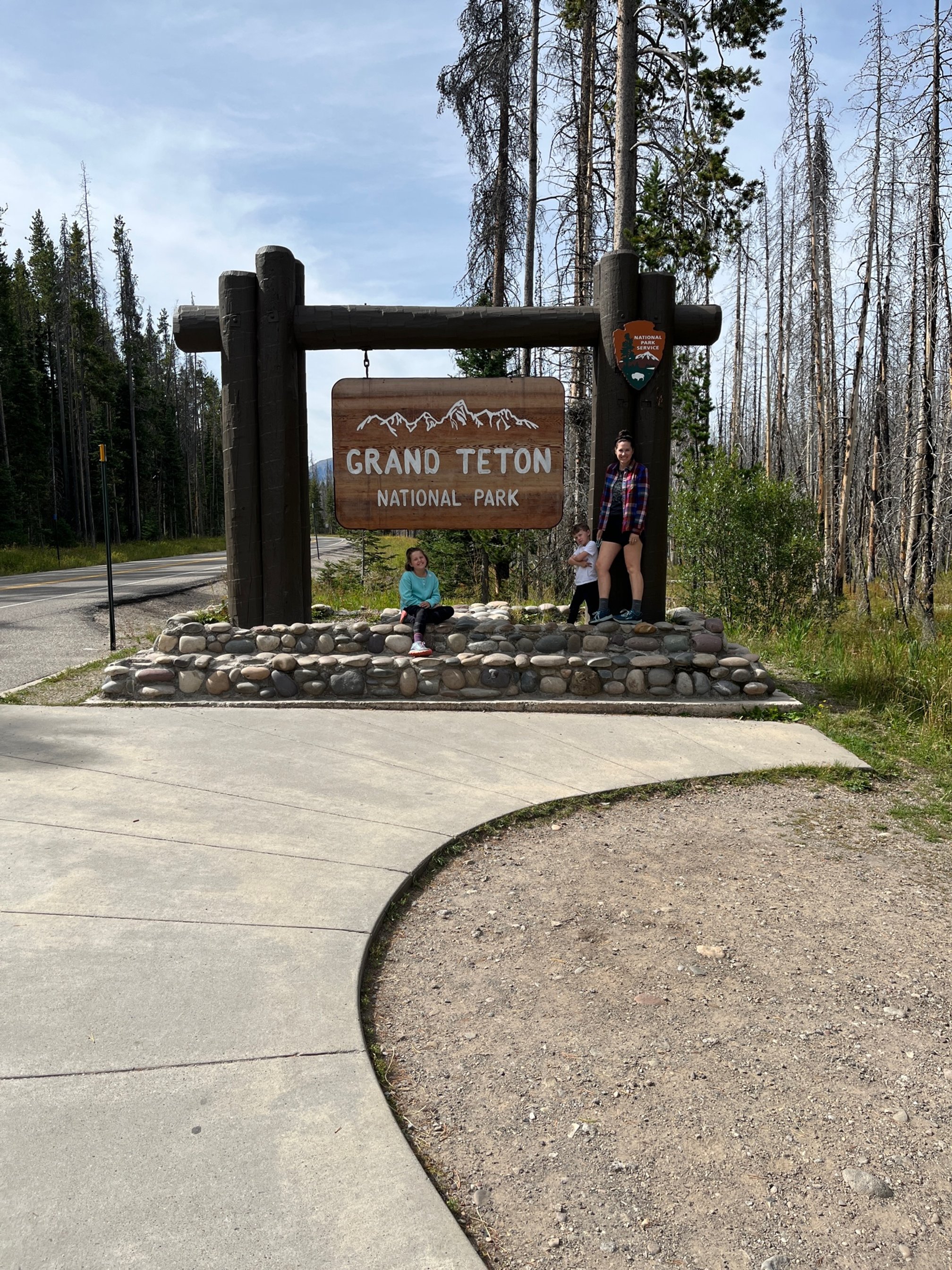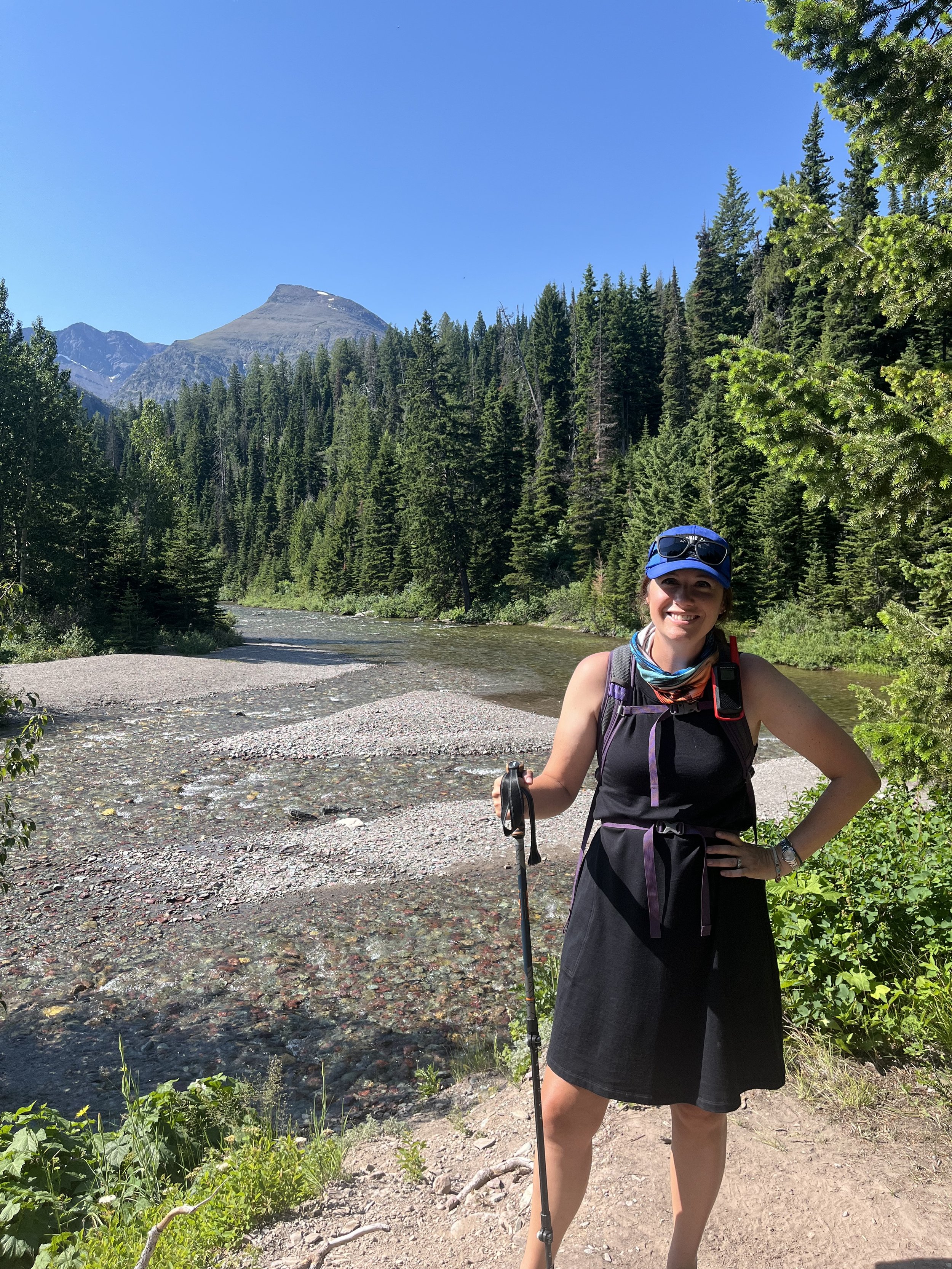Grand Tetons vs. Yellowstone: Which is Better?
Grand Tetons vs. Yellowstone: this is the big question you’ll have to ask while planning a Wyoming national parks trip!
While both parks are incredible, each has its own unique offerings to families looking for outdoor adventures.
The Grand Tetons offer up incredible hikes around pristine lakes and through awe-inspiring mountains, while Yellowstone offers one-of-a-kind thermal features, sweeping valleys filled with wildlife, and a history that spans more than 150 years.
My family loves both of these parks—and I think you should visit both, if possible.
But, if time is limited and you can only do one, you’ll be able to learn more about each park below to find the best fit for your family.
Left: overlook at Grand Teton National Park, right: hydrothermal pool at Yellowstone National Park
This post contains affiliates. If you purchase through the links, I will receive a commission at no charge to you.
Grand Tetons vs. Yellowstone: An Overview
Despite sharing a border and being in the same area of Wyoming, you’d think that visiting Grand Teton and Yellowstone would basically be the same experience twice.
I’m happy to report that is not the case.
Yellowstone National Park is known for its dramatic hydrothermal features: plopping mud pots, bursting geysers, bubbling hot springs, and hissing steam vents. This massive park also has waterfalls, vast plains for visiting wildlife, and a huge lake to explore.
Plus, Yellowstone is the oldest national park in the world, and that OG status is reflected in the sprawling lands and consistent tourism.
Grand Teton National Park to the south is smaller, but just as awe inspiring in its own way. At the heart of the park are the eye-wateringly beautiful Grand Teton mountains, which rise above the sage brush plains and almost guarantee a perfect photo every time.
Here, you have incredible day hikes and backcountry camping, historic pioneer settlements, and river floats to fill up your time.
Both offer up some of the most recognizable natural features in the entire US National Parks system, and they are well worth your time, no matter how long you have to spend here.
To get you started, check out my 5 day Yellowstone and Grand Teton National Park itinerary, where you can see how to balance your time at both parks during a relatively short visit.
Highlights in Grand Teton National Park
Plan your entire national parks vacation with this helpful (and free) collection of Grand Teton National Park resources!
The most perfect morning at Grand Tetons!
Grand Teton National Park is worth a visit thanks to the beautiful mountain chain at the heart of the park.
But there’s so much more here than just the mountains.
After visiting both Grand Teton and Yellowstone National Parks, I can confidently say that Grand Teton has a “wow factor” thanks to the incredible mountain backdrops that you’ll have in all of your photos.
You really cannot take a bad photo in this national park as literally every turnoff and vista is stunning.
Location of Grand Teton
Grand Teton National Park is located about 15 miles north of the adorable town of Jackson, Wyoming.
It’s also the only national park to have a commercial airport inside its border, so you can get started on your vacation here as soon as you step off the plane.
Plus, the park’s southern section is so close to Jackson that it’s easy to run into town if you want a quick bite to eat or need to pick up groceries or outdoor gear.
Annual Visitor Numbers and Reservations
Grand Teton National Park welcomes around 3.4 million visitors each year, and that number continues to tick upwards as more people seek out the incredible places in the NPS.
Yet, the park doesn’t feel crowded for the most part, outside of the stressful parking situations at Jenny Lake Visitors Center and the Laurance S. Rockefeller Preserve. Once you’re beyond your car, the crowds disperse onto the many trails in the park for hiking and biking.
The park is composed of a major scenic loop on Teton Park Road in the southern section, and the John D. Rockefeller Road that connects Jackson, Wyoming, to Yellowstone by cutting through Grand Teton Park.
There’s also the tiny, 2-lane Moose Wilson Road in the southernmost section of the park that leads to the Laurance S. Rockefeller Preserve.
Overall, Grand Teton National Park is easy to navigate and is manageable despite its 310,000 acres. For a first time visitor to this part of Wyoming, Grand Teton is easier than Yellowstone to visit, thanks to its smaller size and proximity to Jackson.
Grand Teton currently does not have a reservations system like other parks (including Arches National Park and Glacier National Park). This means that you simply show up when you’d like, head to the entrance station near Moran, and pay for your vehicle pass. No prior planning is required.
NOTE: If you plan to go to both Yellowstone and Grand Teton on the same trip, I’d recommend that you purchase an America the Beautiful Pass, which is good for entrance to ALL NPS sites—parks, historic sites, national monuments, and national battlefields—for everyone in your vehicle for a year.
You’ll start saving money if you visit just 3 or more NPS sites in a 12 month period. We’ve saved so much on our travels by using this pass! (I’m not an affiliate, just a happy customer.)
Must Do Activities in Grand Teton National Park
Outdoor adventures are everywhere in Grand Teton National Park!
The Camping Kiddos and I at Signal Mountain in Grand Teton National Park
Scenic Drive
If you only have time for one thing in Grand Teton National Park, make it the scenic drive loop in the southern section of the park.
Driving Teton Park Road, a 45-mile loop, will take you past multiple overlooks of the mountain chain, and give you plenty of opportunities for photos (and even a couple of short hikes).
Compare that to the Grand Loop Road in Yellowstone National Park, which, if driven continuously through, would take you about 5.5. hours to do.
Be sure to download the GuideAlong audio tour for Grand Teton to your phone before you start the tour, so that you can learn about the park’s history, geology, wildlife, and more as you drive around.
We love the GuideAlong tours and use them in every park we visit; we like that the audio tour automatically starts and stops as we approach points of interest, and we can re-listen to sections that were interesting (or when my kids were talking over it).
Plus, the tours don’t use WiFi once you’ve downloaded them, making these great for even the more remote areas of the park.
Snake River Float Tour
The Grand Tetons from our rafting tour on the Snake River
You can explore the Snake River via a river rafting tour for a unique view of the majestic Grand Tetons.
We did this with our kids on our most recent trip to Grand Teton National Park, and it was a highlight of our time in the park.
You’ll get a different perspective of the park from driving it, and you’ll be able to see wildlife, including eagles, moose, and elk, that might ordinarily be scared off by car traffic.
The river guides are experienced, and will navigate you down the Snake River with ease, all while sharing fun historical anecdotes about the area.
Read more about our experience on the Snake River float tour here.
Horseback Riding
You can go on a horseback riding tour from Jackson Lake Lodge, which provides a glimpse into what life would’ve been like for the earliest settlers and Native Americans who called this place home.
There are multiple outfitters in the Jackson Hole area that offer up tours on horseback, but the one that’s most convenient to the park is run by the Grand Teton Lodge Company. This offers 1-2 hour trail rides from either Jackson Lake Lodge or Colter Bay Village in the northern part of the park.
For a truly memorable experience, opt for the trail ride and outdoor dinner into the Bridger-Teton National Forest. There’s no other dining option like this in the park, and you will not regret doing this: on a clear summer afternoon, it’s perfection.
Boating
With 44 named lakes inside the park, Grand Teton is filled with boating opportunities.
You can rent a motorboat, kayak, or canoe to explore Jenny Lake, Colter Bay, or Jackson Lake.
Or, if you’d rather someone else do the driving, opt for a guided tour of Jackson Lake; several of these tours come with a meal, for the best in waterfront dining!
Historic Sites
Grand Teton has several areas that are great for history buffs.
You can explore the barns and homes on Mormon Row, which were once home to the LDS pioneers. These are the most well known of the historic sites in the park, and also some of the most photographed.
Over near Moose, you can find the Maud Noble cabin, where a hardy pioneer woman lived in the 1910s while she ran the ferry crossing on the nearby Snake River. This cabin is also where locals gathered to begin the process of protecting this area into a national park in the early 1920s.
Outside of the Maud Noble cabin is the Menor’s Ferry area, where you can find an old wooden ferry, William Menor’s cabin and general store, an outhouse, and a barn with antique vehicles.
Learn more with my complete trail guide to the Menor’s Ferry historic district here.
Other Itineraries for Grand Teton:
Hiking in Grand Teton National Park
And, of course, there are so many easy hikes in Grand Teton National Park to get the entire family out on the trail!
From the trail around Jenny Lake to the hike to Phelps Lake in the Laurance S. Rockefeller Preserve, there are dozens of beautiful hikes in the park. If you’re feeling adventurous, you can take an overnight backpacking trip into Cascade Canyon and truly escape the crowds.
One of the most popular hikes in Grand Teton is to Inspiration Point and Hidden Falls. From the top of Inspiration Point, you can see for miles across Jenny Lake into Jackson Hole.
As you hike, keep an eye out for wildlife at Grand Teton National Park that you won’t see as often as Yellowstone, particularly moose.
Both of the moose we saw in this area of Wyoming were both in Grand Teton.
On your hikes, you may also see elk, ravens, owls, pikas, and bears. (So, be sure to carry bear spray with you at all times!)
Camping and Accommodations in Grand Teton National Park
This park has several excellent lodges, cabins, and campgrounds. From south to north within the park, here are the lodging and camping options:
Gros Venture campground is at the southern edge of the park, near the National Elk Refuge. There are both tent and RV camping sites, many of which have electric hookups. There is a dump station on-site.
Jenny Lake Lodge includes adorable cabins on the edge of the titular lake and is only accessible by a separate scenic path, so you won’t have much traffic going by. The Jenny Lake campground is nearby if you’re tent camping (no RVs here).
Signal Mountain campground is for tent camping and RVs under 30 feet. About a 1/3rd of the sites have electric hookups, and the campground offers paid showers and a laundry.
Jackson Lake Lodge is gorgeous with a huge window on its second floor overlooking the mountains. There are several shops and restaurants in the main building.
Over in Colter Bay Village, you’ll find both a campground and cabins. We stayed in the Colter Bay cabins, which are spacious and great for families. Read my complete Colter Bay cabins review here. The campground offers both full hook-up sites for RVs and standard tent sites.
On the shores of Jackson Lake in the north of the park, you’ll find 30 standard tent sites at Lizard Creek campground. RVs are welcome, but they must be under 30-feet.
Finally, Headwaters campground has cabins, full hook-up RV sites, and tent sites.
Kids in Grand Teton National Park
PIN ME!
While both Grand Teton National Park and Yellowstone National Park have incredible learning opportunities, Grand Teton felt a bit less risky than Yellowstone.
Part of this has to do with the fact that Yellowstone is on top of an active supervolcano, and there are fascinating—but harmful—boiling pools of water underneath thin crusts, bubbling mud volcanos, and spurting geysers everywhere in the park.
While I didn’t hesitate to take my 6- and 10-year olds to either of these parks, I would likely feel more comfortable doing Grand Teton National Park over Yellowstone if I had very small kids (like toddler and preschool aged).
If you’re traveling with kids who’d like to complete the Junior Ranger program at Grand Teton National Park, the ranger booklet has shorter requirements that the one over at Yellowstone.
We also went on a Snake River float within Grand Teton, which my kids loved.
We also felt that the food options for kids were better in Grand Teton National Park, with excellent restaurants serving up pizza, pasta, burgers, wraps, mac and cheese, and more. You’ll find more information in my guide on where to eat in Grand Teton National Park, but the food in this park felt more varied and fresher than that in Yellowstone.
>> Read more about visiting with a family in my guide to Grand Teton National Park with kids. <<
While visiting Yellowstone National Park and/or Grand Teton National Park, I highly recommend using the GuideAlong app to make your journey more interesting and insightful.
The GuideAlong app tours are GPS based, meaning they don’t need Wifi after the initial download, and the tour starts and stops automatically as you get to each point of interest.
We used the GuideAlong tours for both of these parks, and we were blown away by the content, which helped give us much needed context for what we were seeing.
You’ll get commentary on each park’s history, geology, trailheads, overlooks, and more. It was like having a live tour guide in the car with us!
You can get the parks separately:
Or, you can save about 30% by buying the bundle:
NOTE: I purchased both of the recommended tours on my own, and I do not work for GuideAlong. The above links are affiliate links, which means I will get a small commission if you book a tour through the links. I only recommend items that I stand by and believe will truly enrich your family experiences.
Highlights in Yellowstone National Park
Plan your entire national parks vacation with this helpful (and free) collection of Yellowstone National Park resources!
Welcome to THE original national park!
The oldest national park in the world, Yellowstone National Park is a can’t-miss, once-in-a-lifetime family vacation.
You’ll see things here that you can’t see anywhere else in the world, and, for all of the park’s infrastructure, it still feels very wild.
Within its boundaries, the park has 7 main areas:
Grant Village/ West Thumb, southern Yellowstone
Old Faithful Geyser Basin, southern Yellowstone
Norris Geyser Basin, western Yellowstone
Canyon Village, eastern Yellowstone
Lake Yellowstone/ Fishing Bridge, eastern Yellowstone
Tower-Roosevelt, northeastern Yellowstone
Mammoth Hot Springs, northwestern Yellowstone
All of these have amenities, including hotels, cabins, campgrounds, restaurants, gas stations, and gift shops.
Learn more about where to eat in Yellowstone here.
Location of Yellowstone National Park
Because Yellowstone is huge, you’ll need to plan your approach much more than when you’re visiting Grand Teton National Park.
The 7 areas above are serviced by 5 different entrance points across 3 states (Wyoming, Montana, and Idaho). Just determining which entrance you’d like to use can be a challenging, so check out my guide that compares the Yellowstone entrances.
Yellowstone takes up a massive chunk of Wyoming, and inches out into Montana and Idaho in its northern and western sections.
Annual Visitor Numbers and Reservations
Each year, Yellowstone National Park welcomes around 4 million visitors, which puts it in the top 5 of most visited national parks in the US.
While that number might seem daunting, it is actually easy to get away from the crowds if you’re willing to get away from the major points of interest like Old Faithful and Grand Prismatic Springs. Most visitors don’t get more than 250 feet from their car, so if you head out onto a trail—ANY TRAIL—you’re drastically reducing the number of people around you.
While that 4 million visitors is expected to climb over the next few years, Yellowstone has, so far, resisted adding in a reservation system.
As of the writing of this post, you simply show up to one of the entrances, pay your entrance fee, and head on your merry way.
Plan your entire national parks vacation with this helpful (and free) collection of Yellowstone National Park resources!
Must Do Activities in Yellowstone
Unique hydrothermal features
My son at the Grand Prismatic Pool Overlook
The park is best known for its many, many, MANY hydrothermal features—about 12,000 at last count!
These hydrothermal features come in 4 varieties:
Hot springs,
Fumeroles (or steam vents),
Mud pots, and
Geysers.
While you can find hot springs of different varieties elsewhere in the US, the other types are far less common.
You’ll be treated to the timely and grandiose gush of Old Faithful, one of the park’s most famous icons.
There’s also the gorgeous Grand Prismatic Spring, Artists Paint Pots, and Dragon’s Mouth, which were our favorite features in the park.
All of the park’s best hydrothermal features can be found along our favorite easy hikes in Yellowstone National Park.
Hiking guides to our favorite trails:
Driving the Grand Loop
Yellowstone is made up of 2 roughly circular roads stacked on top of one another, kind of like a figure 8. Driving this entire route will allow you to see everything that Yellowstone has to offer.
You can learn about the best stops along Grand Loop Road here.
Rarely have I seen such dramatic changes in such a relatively short driving time—the only other experience I’ve had like this was when we did the Denver to Grand Canyon road trip and went from the Rockies to the desert in less than 200 miles.
Those geographical changes and vast area of the park means you can experience many different things in one trip.
Unlike the Grand Tetons, which offers up variations on mountain, river, and lake, Yellowstone has something new around just about every turn.
Check out my 2 days in Yellowstone itinerary!
Yellowstone also had rivers, lakes, and mountain passes, but it also had a canyon, waterfalls, valleys, and those hydrothermal features.
Wildlife Viewing
We found that the wildlife in Yellowstone was much more prevalent than in Grand Teton, seeing elk, bison, coyotes, pronghorn, ravens, swans, and more in our first few days.
While you can see animals just about anywhere in the park, there are 2 areas where they tend to congregate.
The first is in Hayden Valley between Canyon Village and Fishing Bridge on the lower loop. There are rolling hills, marshes, and forests, perfect for wildlife spotting.
The second is in Lamar Valley, which is larger and stretches from Tower-Roosevelt to the remote north entrance of the park near Cooke City, Montana. If you’re doing this scenic drive, be sure to extend it by driving the Beartooth Highway, one of the prettiest roads in the United States.
Beartooth Highway has some beautiful overlooks, accessible trails, and several lakes. One of our favorite stops along the way is Island Lake, which has a boat ramp, hiking trails, and campground.
Full Island Lake Campground review here.
Horseback Riding
Pleasant Valley, the home of the Old West Dinner Cookout
Like Grand Teton National Park, Yellowstone also has horseback tours, which are a great way to get away from the crowds and into the back country.
The corrals at Tower-Roosevelt in the northern section of the park has a variety of trail rides, including 1, 2 and 4 hour trips.
The Old West Dinner Cookout also leaves from that same corral and is a blast. That trail ride and dinner ended up being one of my family’s favorite parts of our trip!
You can ride a horse to the dinner site or climb aboard a historic stagecoach if you’re not a horse person. You’ll be following a stagecoach trail in use from the mid-1800s either way.
Hiking in Yellowstone National Park
You could spend a month hiking in Yellowstone and still only see a tiny portion of the trails here.
With such an expansive park, you can opt for backcountry, overnight camping trips, or for easy day hikes in Yellowstone.
I love that there are SO many options here so that anyone can get out onto the trails.
Many of the geyser boardwalks are handicap and stroller accessible, so that all visitors can access parts of this incredible park.
Kids in Yellowstone National Park
If you have a budding scientist or biologist, there’s no better place to visit than Yellowstone.
The Camping Kiddos and me at Old Faithful!
All of the steaming, bubbling, and boiling features are fascinating for kids (and kids at heart!), and they start so many great conversations about volcanos, tectonic plates, and more.
The variety of wildlife was another high point for my kids, who got to see bison right next to our car on several occasions.
The Junior Ranger program is one of the most in-depth that I’ve seen since we started doing these programs. While the program did take longer to complete than most, I appreciated how much my kids learned from completing their booklets.
The number and quality of the ranger walks here is excellent!
We went on several ranger walks, and the ranger guides always made sure to include our kids in the discussions. Plus, these talks are always free, which is helpful on any budget.
Due to the drive times between activities and the types of things you’ll see along the way, I think this park is best for kids in first grade and up.
My 6-year-old enjoyed the science here immensely.
>> Explore more with my complete Yellowstone Family Vacation guide! <<
Which Wyoming National Park is better for kids?
I think that Grand Teton National Park is excellent for all ages, as there are many family friendly activities for outdoor adventurers young and old.
It’s an excellent mountain destination with easy access to restaurants, lodging, an airport, and Jackson, Wyoming.
The park feels more rugged thanks to the beautiful peaks that run the length of the park, and it is great for hiking families.
On the other hand, I think that Yellowstone National Park is best appreciated by kids in elementary school and up, who will be able to grasp the incredible natural features present there.
The wildlife and vast options for activities ensures that every day of a Yellowstone National Park vacation will be different!
For a truly incredible vacation, split your time between these parks so you can get the best of both experiences.
Which is better for hiking: Grand Tetons vs. Yellowstone?
Both of these parks offer more hiking trails that you could dream of doing on one vacation, so you can’t go wrong if you just want to get on a trail.
It really comes down to what kind of hiking you’d like to do, as the experience in each park is so different. While there is some elevation in Yellowstone, you won’t get true mountain hiking there.
Instead, you’ll need to head to Grand Teton, where you can do an overnight backpacking trip up into the peaks.
If you’re looking for wildlife on your hikes, Yellowstone is the better as you will likely encounter elk or bison just by strolling around the parks.
Both parks have a wide variety of hiking opportunities, so you can pick longer, more intense trails if you’re a seasoned hiker or a shorter, easier trail if you’re hiking with kids or as a beginning hiker.
I will note that both parks can be tough to hike if you’re coming from a lower altitude, so give yourself time to acclimatize even if you’re a regular on the trail.
Is Grand Teton or Yellowstone better to visit in the summer?
Because of the mild summers, these two parks see the bulk of their visitors between May and early September.
Yet, the parks can still see wild fluctuations in temperature—and even snow!—in June and July. Because of this, you’ll need to prepare for anything in your wardrobe no matter which park you’re visiting.
Both are beautiful in the summer with wildflowers along the trails, active animals, and weather that’s perfect for hiking or kayaking.
Yellowstone gets very busy in the summer, especially around Old Faithful and Grand Prismatic Springs, so if you’re going to visit those, do so early in the mornings.
Grand Teton similarly has high traffic areas like Jenny Lake Visitors Center, but the old standby tip of getting there early helps to avoid much of the tourist traffic.
You really cannot go wrong visiting either (or both!) of these parks in the summer, despite it being peak season. Plan accordingly and carefully time your days in both. You can also stick to lesser known attractions—Yellowstone has many geysers and not just Old Faithful, for example—to also manage the crowds.
If you’re adding Glacier National Park to your explorations in Yellowstone and Grand Teton, check out our massive guide to visiting Glacier with kids here!
What to bring to Grand Teton and Yellowstone National Parks
Whether you plan to visit one or both parks, you’ll need to prepare. While both parks have restaurants, hotels, and other amenities, what you will find are more expensive than they are in the towns outside of the parks. Some areas of Yellowstone, especially, are quite remote and a long way to the next food stop.
Here are the things you should pack for exploring both national parks.
Food
Between Grand Teton and Yellowstone, you’ll find dozens of restuarants and a handful of convenience stations. So, why am I recommending that you bring food?
First, the food you’ll find in the parks is expensive for what you get, and even grab and go chips, yogurt, and candy bars are higher than what you’d pay at a regular gas station. Stocking up before hand will save you money and give you a much better selection.
The weather in Wyoming is dry and you’re at a high elevation, so you’ll want to be prepared for that. To hold off on altitude sickness, eat regularly to keep your blood sugar stable and be sure to include potassium-rich and complex carbs to do so.
Be sure to pack heartier fare, too, as hiking and exploring around the park will quickly burn calories. We’ve found that sandwiches, pasta salads, fruit, and granola bars make for a filling but quick lunch.
Cooler
To help with your food and drinks, be sure to pack a cooler with ice before you head into the park.
Not only does this open up new options for snacks and meals, but you’ll also have the best treat of all after a hike: an icy cold drink.
If you need to buy a disposable cooler, you can find one in Jackson at the Albertson’s or in Gardiner at Ridley’s Market.
Gas
Don’t start the day on empty, or you’ll be stressed as you drive through the parks.
While Yellowstone National Park has several Sinclair gas stations, they are expensive, so try to fill up before you get into the park. They’re also far apart from one another, so it’s always good to top up whenever you see one.
Grand Teton National Park has 3 gas stations: one at Dornan’s, one near Signal Mountain, and one near Colter Bay Village.
Hiking day pack
Stay hydrated with snacks on hand with a hiking day pack. Even if you plan to stick to some of the shorter hikes in the park, you’ll want to ensure that you have a good day pack that you can take with you.
If you did manage to wander off trail, you’ll want to ensure that you have your food, water, and GPS with you.
I have an Osprey Daylight that I use for my day pack, which works well for shorter hikes. I carried that bag with me throughout our most recent visits to both Grand Teton and Yellowstone, and it worked well.
It’s big enough to put all of the things that the kids and I need during a hike (our Garmin Inreach Mini, snack bars, cell phone, first aid essentials), but small enough to be lightweight for a shorter day hike.
Extra water
If you plan to take a hike in either of these parks especially in the summer, please (please!) take at least twice the amount of water you think you’ll need.
It can get hot mid-day in the summer in the parks, and staying hydrated is an important way to combat altitude sickness. So, keep sipping that water, even if you’re not dying of thirst.
Your hiking pack should include a water bladder; fill it up before you leave for your hike. A 2-2.5L water bladder should work for most people for a day hike, but anticipate your specific needs.
Keep cold water in your cooler in the car for additional resources.
There are areas in both Grand Teton and Yellowstone to fill your water in/near the visitors centers, and you can buy bottled water at the lodge stores, campgrounds, and gas stations.
Hiking shoes
Other than the paved sections of trail at Jenny Lake and the boardwalks near the geysers in Yellowstone, you are likely going to be hiking on a combination of packed dirt and rock in these parks.
Tennis shoes are not going to be able to provide the appropriate grip on the dirt trails (which are often muddy in the summer), and flip flops are even worse.
When hiking in the summer, I prefer to wear my Keen Newport H2 hiking sandals, which have a closed toe and back strap, but holes along the side for ventilation. Even in the summer, it can get chilly in both parks, so I will opt for my Altra TIMP 4 trail runners plus my beloved Darn Tough wool socks.
Hat
Hiking in Grand Teton and Yellowstone offers up a unique experience on each trail. In the morning, you might be exploring near geysers, where there isn’t any tree coverage, then head out on a mountain hike in Grand Teton in the afternoon.
To be prepared for the ever changing conditions, I recommend wearing some sort of hat while you’re on the trails here: a wide brimmed sun hat or a baseball cap are great options for sun protection and a bit of extra warmth if the temperatures randomly plummet.
Final Thoughts on Grand Tetons vs. Yellowstone
If you only have one day in this area, I’d suggest driving the scenic loop in Grand Teton and then scooting into Yellowstone’s southern section to see the famed Old Faithful geyser.
In reality, though, you need more than a single day to see either of these parks. And you truly need to see both to get a grasp on Wyoming’s incredible ecosystems, wildlife, and geology.
If you’re planning to stay in Jackson, Grand Teton National Park is the obvious place to spend your time, but Yellowstone is SO big that it can be added onto other trips from Bozeman, Montana, Cody, Wyoming, or West Yellowstone, Montana.
Yellowstone National Park is iconic, thanks to its place in national parks history, but Grand Teton offers up a mountain vacation like none other.
Ultimately, you can’t go wrong with either Yellowstone or Grand Teton, and a trip to either (or both!) will be a highlight in your trip to Wyoming.


